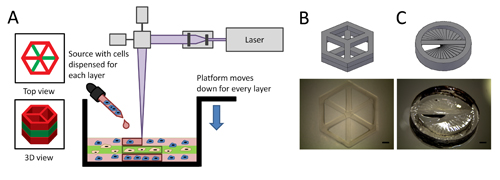Research: >> Past >> Integrated Microfluidic Devices...
Micro- and Nano-Mediated Cardiac Tissue Engineering
V. Chan, P. Zorlutuna, P. Bajaj, H.J. Kong, T. Saif, B. Cunningham, L. Schook, R. Bashir; University of Illinois, Urbana-Champaign
The regeneration of cells and tissue after injury or trauma is critical to medical and civilian communities. Cardiac injuries and regenerative engineering poses specific challenges since cardiac myocytes, the primary cells responsible for the mechanical beating of the heart muscle, do not regenerate. The cardiac system poses a significantly challenging problem in tissue engineering due to the complex 3-dimensional mechano-actuation properties of the cardiac cells. A grand challenge in cardiology since early 50s is the development of an artificial heart that can replace a failing heart. Until today, artificial heart is used only for the temporary use (hrs) until a healthy donor heart is found. The latter is difficult to get, and is often rejected by the body after successful replacement. This very limited success in heart replacement, in spite of considerable effort and resources invested so far, calls for a new paradigm in the approach of heart replacement. This project attempts to offer such a paradigm by proposing to “grow” the heart or its components from the basic building blocks, namely the cells (differentiated cardiomyocytes) of the patient, biomaterials design, namely the hydrogels scaffolds to house the cells, and nanotechnology, namely the stereo-lithographically-patterned 3D substrate. New knowledge on cells’ response to mechanical cues, and recent findings on cardiomyocyte functionality on mechanically tuned substrates from our labs form the basis for the project. In summary, stem cell differentiation in scaffolds, novel 3-D fabrication technologies, use of the appropriate bio-materials, integration of peptides for cardiac cell attachment and cell growth, the characterization of the scaffold materials and the transmembrane proteins, and cardiac cell mechanics are all critical elements of a comprehensive design approach proposed in this project for 3-D cardiac tissue engineering.

Figure (A) Schematic representation of the SLA; (B and C) CAD-based drawings and stereomicroscopic images of complex 3D hydrogels prepared from poly(ethylene glycol) in the SLA.



This project was made possible by a cooperative agreement that was awarded and administered by the U.S. Army Medical Research & Materiel Command (USAMRMC) and the Telemedicine & Advanced Technology Research Center (TATRC), under contract #:W81XWH0810701.